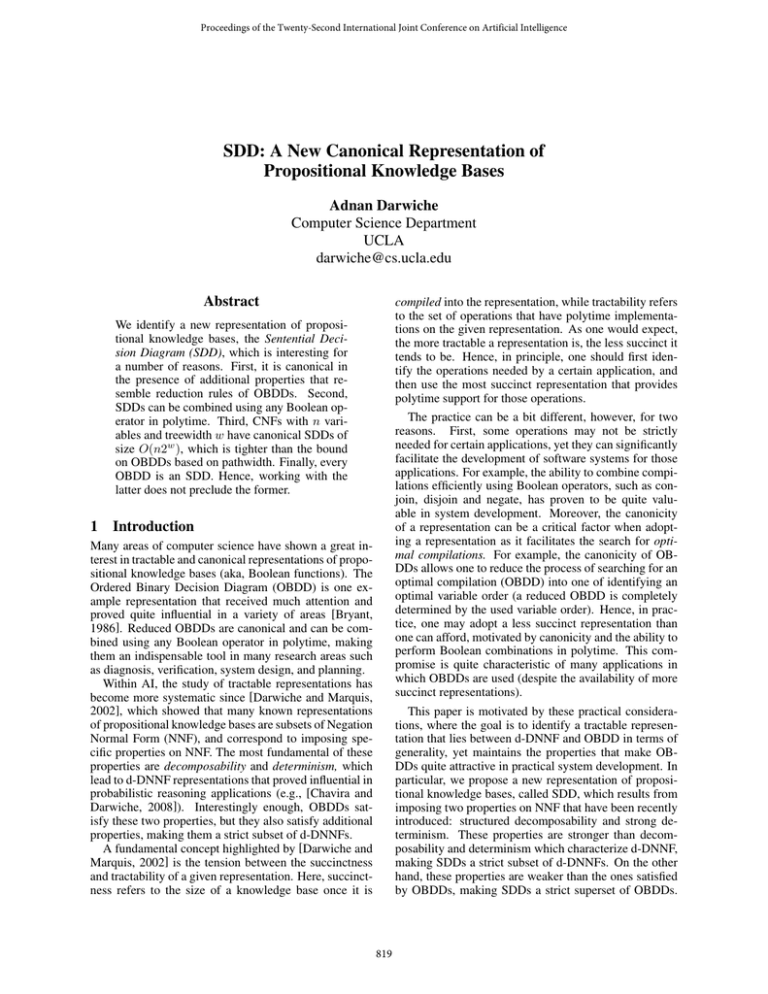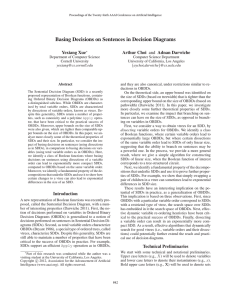SDD: A New Canonical Representation of Propositional Knowledge Bases Adnan Darwiche
advertisement

Proceedings of the Twenty-Second International Joint Conference on Artificial Intelligence
SDD: A New Canonical Representation of
Propositional Knowledge Bases
Adnan Darwiche
Computer Science Department
UCLA
darwiche@cs.ucla.edu
Abstract
compiled into the representation, while tractability refers
to the set of operations that have polytime implementations on the given representation. As one would expect,
the more tractable a representation is, the less succinct it
tends to be. Hence, in principle, one should first identify the operations needed by a certain application, and
then use the most succinct representation that provides
polytime support for those operations.
We identify a new representation of propositional knowledge bases, the Sentential Decision Diagram (SDD), which is interesting for
a number of reasons. First, it is canonical in
the presence of additional properties that resemble reduction rules of OBDDs. Second,
SDDs can be combined using any Boolean operator in polytime. Third, CNFs with n variables and treewidth w have canonical SDDs of
size O(n2w ), which is tighter than the bound
on OBDDs based on pathwidth. Finally, every
OBDD is an SDD. Hence, working with the
latter does not preclude the former.
1
The practice can be a bit different, however, for two
reasons. First, some operations may not be strictly
needed for certain applications, yet they can significantly
facilitate the development of software systems for those
applications. For example, the ability to combine compilations efficiently using Boolean operators, such as conjoin, disjoin and negate, has proven to be quite valuable in system development. Moreover, the canonicity
of a representation can be a critical factor when adopting a representation as it facilitates the search for optimal compilations. For example, the canonicity of OBDDs allows one to reduce the process of searching for an
optimal compilation (OBDD) into one of identifying an
optimal variable order (a reduced OBDD is completely
determined by the used variable order). Hence, in practice, one may adopt a less succinct representation than
one can afford, motivated by canonicity and the ability to
perform Boolean combinations in polytime. This compromise is quite characteristic of many applications in
which OBDDs are used (despite the availability of more
succinct representations).
Introduction
Many areas of computer science have shown a great interest in tractable and canonical representations of propositional knowledge bases (aka, Boolean functions). The
Ordered Binary Decision Diagram (OBDD) is one example representation that received much attention and
proved quite influential in a variety of areas [Bryant,
1986]. Reduced OBDDs are canonical and can be combined using any Boolean operator in polytime, making
them an indispensable tool in many research areas such
as diagnosis, verification, system design, and planning.
Within AI, the study of tractable representations has
become more systematic since [Darwiche and Marquis,
2002], which showed that many known representations
of propositional knowledge bases are subsets of Negation
Normal Form (NNF), and correspond to imposing specific properties on NNF. The most fundamental of these
properties are decomposability and determinism, which
lead to d-DNNF representations that proved influential in
probabilistic reasoning applications (e.g., [Chavira and
Darwiche, 2008]). Interestingly enough, OBDDs satisfy these two properties, but they also satisfy additional
properties, making them a strict subset of d-DNNFs.
A fundamental concept highlighted by [Darwiche and
Marquis, 2002] is the tension between the succinctness
and tractability of a given representation. Here, succinctness refers to the size of a knowledge base once it is
This paper is motivated by these practical considerations, where the goal is to identify a tractable representation that lies between d-DNNF and OBDD in terms of
generality, yet maintains the properties that make OBDDs quite attractive in practical system development. In
particular, we propose a new representation of propositional knowledge bases, called SDD, which results from
imposing two properties on NNF that have been recently
introduced: structured decomposability and strong determinism. These properties are stronger than decomposability and determinism which characterize d-DNNF,
making SDDs a strict subset of d-DNNFs. On the other
hand, these properties are weaker than the ones satisfied
by OBDDs, making SDDs a strict superset of OBDDs.
819
Consider decompositions {(A, B), (¬A, false)} and
{(A, B)} of f = A ∧ B. The first is an A-partition.
The second is not. Decompositions {(true, B)} and
{(A, B), (¬A, B)} are both A-partitions of f = B. The
first is compressed. The second is not since its subs are
not distinct. A decomposition is compressed by repeated
replacement of elements (p, s) and (q, s) with (p ∨ q, s).
Following are useful observations about X-partitions.
First, false can never be prime by definition. Second, if
true is prime, then it is the only prime. Third, primes
determine subs. Hence, if two X-partitions of a function
f are distinct, their primes must form different partitions.
Ordered Binary Decision Diagrams (OBDDs) are
based on the Shannon decomposition of a function f ,
{(X, f |X), (¬X, f |¬X)}, which is an X-partition of f .
Here, decisions are binary since they are based on the
value of literal primes (X or ¬X). On the other hand,
Sentential Decision Diagrams (SDDs) are based on Xpartitions, where X is a set of variables instead of being
a single variable. As a result, decisions are not binary as
they are based on the value of sentential primes.
The following property of partitioned decompositions
is responsible for many properties of SDDs.
Despite their generality, SDDs maintain the key properties of OBDDs, including canonicity and a polytime support for Boolean combinations. They also come with a
tighter bound on their size in terms of treewidth.
The SDD is inspired by two recent discoveries. The
first is structured decomposability [Pipatsrisawat and
Darwiche, 2008], which is based on the notion of vtrees
that generalize variable orders. The second is strongly
deterministic decompositions [Pipatsrisawat and Darwiche, 2010a], which generalize the Shannon decomposition on which OBDDs are based. Combining vtrees
and this class of decompositions leads to the new representation. The foundations of SDDs are presented in
Section 2; their syntax and semantics in Section 3; their
canonicity in Section 4; their Boolean combination in
Section 5; their relation to OBDDs in Section 6; and their
upper bound based on treewidth in Section 7. Preliminary empirical results and a discussion of related work
appear in Section 8. We will provide proofs or proof
sketches for many of our results in this paper, leaving
some to the full technical report.
2
Strongly deterministic decompositions
Theorem 2 Let ◦ be a Boolean operator and let
{(p1 , s1 ), . . . , (pn , sn )} and {(q1 , r1 ), . . . , (qm , rm )} be
X-partitions of f (X, Y) and g(X, Y). Then {(pi ∧
qj , si ◦ rj ) | pi ∧ qj = false} is an X-partition of f ◦g.
We start with some technical and notational preliminaries. Upper case letters (e.g., X) will be used to denote
variables and lower case letters to denote their instantiations (e.g., x). Bold upper case letters (e.g., X) will
be used to denote sets of variables and bold lower case
letters to denote their instantiations (e.g., x).
A Boolean function f over variables Z maps each instantiation z to 0 or 1. The conditioning of f on instantiation x, written f |x, is a subfunction that results from
setting variables X to their values in x. A function f essentially depends on variable X iff f |X = f |¬X. We
write f (Z) to mean that f can only essentially depend
on variables in Z. A trivial function maps all its inputs
to 0 (denoted false) or maps them all to 1 (denoted true).
Consider a Boolean function f (X, Y) with
non-overlapping variables X and Y.
If
f = (p1 (X) ∧ s1 (Y)) ∨ . . . ∨ (pn (X) ∧ sn (Y)),
then {(p1 , s1 ), . . . , (pn , sn )} is called an (X, Y)decomposition of function f as it allows one to express
f in terms of functions on X and on Y only [Pipatsrisawat and Darwiche, 2010a]. If pi ∧pj = false for i = j,
the decomposition is said to be strongly deterministic on
X [Pipatsrisawat and Darwiche, 2010a]. In this case,
we call each ordered pair (pi , si ) an element of the
decomposition, each pi a prime and each si a sub. The
decomposition size is the number of its elements.
SDDs utilize a more structured decomposition type.
Proof Since p1 , . . . , pn and q1 , . . . , qm are partitions,
then pi ∧ qj is also a partition for i = 1, . . . , n, j =
1, . . . , m and pi ∧pj = false. Hence, the given decomposition is an X-partition of some function. Consider now
an instantiation xy of variables XY. There must exist a
unique i and a unique j such that x |= pi and y |= qj .
Moreover, f (xy) = si (y), g(xy) = rj (y) and, hence,
[f ◦g](xy) = si (y)◦rj (y). Evaluating the given decomposition at instantiation xy also gives si (y)◦rj (y). According to Theorem 2, the X-partition of f ◦g has
size O(nm), where n and m are the sizes of X-partitions
for f and g. This is the basis for a future combination
operation on SDDs that has a similar complexity.
Let f = A ∨ B, g = A ∧ B and consider the
corresponding A-partitions {(A, true), (¬A, B)} and
{(A, B), (¬A, false)}. The following is an A-partition
for f ⊕g: {(A, true ⊕B), (¬A, B⊕false)} which equals
{(A, ¬B), (¬A, B)}.
Let f = A ∨ C , g = B ∨ C and consider the
corresponding {A, B}-partitions {(A, true), (¬A, C)}
and {(B, true), (¬B, C)}. Theorem 2 gives {(A ∧
B, true), (A ∧ ¬B, true), (¬A ∧ B, true), (¬A ∧
¬B, C)} as an {A, B}-partition for f ∨ g. This is not
compressed since its subs are not distinct. We compress
it by simply disjoining the primes of equal subs, leading
to {(A ∨ B, true), (¬A ∧ ¬B, C)}.
The canonicity of SDDs is due to the following result.
Definition 1 Let α = {(p1 , s1 ), . . . , (pn , sn )} be an
(X, Y)-decomposition of function f that is strongly deterministic on X. Then α is called an X-partition of f
iff its primes form a partition (each prime is consistent,
every pair of distinct primes are mutually exclusive, and
the disjunction of all primes is valid). Moreover, α is
compressed iff its subs are distinct (si = sj for i = j).
Theorem 3 A function f (X, Y) has exactly one compressed X-partition.
820
Proof Let x1 , . . . , xk be all instantiations of variables X. Then {(x1 , f |x1 ), . . . , (xk , f |xk )} is an Xpartition of function f . Let s1 , . . . , sn be the distinct
subfunctions
in f |x1 , . . . , f |xk . For each si , define
pi = f |xj =si xj . Then α = {(p1 , s1 ), . . . , (pn , sn )}
is a compressed X-partition of f .
Suppose that
β = {(q1 , r1 ), . . . , (qm , rm )} is another compressed Xpartition of f . Then α and β must have different partitions. Moreover, there must exist a prime pi of α that
overlaps with two different primes qj and qk of β. That
is, x |= pi , qj and x |= pi , qk for some instantiations
x = x . We have f |x = α|x = si = rj = β|x and
f |x = α|x = si = rk = β|x . Hence, rj = rk . This is
impossible as β is compressed. Let α = {(p1 , s1 ), . . . , (pn , sn )} be an X-partition
for function f . Then β = {(p1 , ¬s1 ), . . . , (pn , ¬sn )}
is an X-partition for its negation ¬f . This follows from
Theorem 2 while noticing that ¬f = f ⊕ true. Moreover, if α is compressed, then β must be compressed as
well. Consider function f = A ∨ B and A-partition
{(A, true), (¬A, B)}. Then {(A, false), (¬A, ¬B)} is
an A-partition of function ¬f = ¬A ∧ ¬B.
Following is the second key notion underlying SDDs.
6
⊤
6
2
0
B
2
5
1
3
A
D
(a) vtree
C
2
¬B
5
4
C
B A
¬B ⊥
B ¬A
D C
¬D ⊥
(b) Graphical depiction of an SDD
Figure 1: Function f = (A ∧ B) ∨ (B ∧ C) ∨ (C ∧ D).
3
The syntax and semantics of SDDs
We will use . to denote a mapping from SDDs into
Boolean functions. This is needed for semantics.
Definition 5 α is an SDD that respects vtree v iff:
— α = ⊥ or α = .
Semantics: ⊥ = false and = true.
— α = X or α = ¬X and v is a leaf with variable X.
Semantics: X = X and ¬X = ¬X.
Definition 4 A vtree for variables X is a full binary tree
whose leaves are in one-to-one correspondence with the
variables in X.
— α = {(p1 , s1 ), . . . , (pn , sn )}, v is internal,
p1 , . . . , pn are SDDs that respect subtrees of v l ,
s1 , . . . , sn are SDDs that respect subtrees of v r , and
partition.
p1 , . . . , pn is a
n
Semantics: α = i=1 pi ∧ si .
Figure 1(a) depicts a vtree for variables A, B, C and D.
As is customary, we will often not distinguish between
node v and the subtree rooted at v, referring to v as both
a node and a subtree. Moreover, v l and v r denote the left
and right children of node v.
The vtree was originally introduced in [Pipatsrisawat
and Darwiche, 2008], but without making a distinction
between left and right children of a node. In this paper, the distinction is quite important for the following
reason. We will use a vtree to recursively decompose a
Boolean function f , starting at the root of a vtree. Consider node v = 6 in Figure 1(a) which is root. The left
subtree contains variables X = {A, B} and the right
subtree contains Y = {C, D}. Decomposing function
f at this node amounts to generating an X-partition of
function f . The result is quite different from generating a Y-partition of the function. The SDD representation we shall present next is based on a recursive application of this decomposition technique. In particular, if
{(p1 , s1 ), . . . , (pn , sn )} is the decomposition of function
f at node v = 6, then each prime pi will be further decomposed at node v l = 2 and each sub si will be further
decomposed at node v r = 5. The process continues until
we have constants or literals.
The formal definition of SDDs is given next, after one
more comment about vtrees. Each vtree induces a total
variable order that is obtained from a left-right traversal
of the vtree. The vtree in Figure 1(a) induces the total
variable order B, A, D, C. We will have more to say
about these total orders when we discuss the relationship
between SDDs and OBDDs.
The size of SDD α, denoted |α|, is obtained by summing
the sizes of all its decompositions.
A constant or literal SDD is called terminal. Otherwise,
it is called a decomposition. An SDD may respect multiple vtree nodes. Consider the vtree in Figure 1(a). The
SDD {(
, C)} respects nodes v = 5 and v = 6. However, if an SDD respects node v, it will only mention
variables in subtree v.
For SDDs α and β, we will write α = β to mean
that they are syntactically equal. We will write α ≡ β
to mean that they represent the same Boolean function:
α = β. It is possible to have α ≡ β and α = β:
α = {(X, γ), (¬X, γ)} and β = {(
, γ)} is one such
example. However, if α = β, then α ≡ β by definition.
We will later provide further conditions on SDDs which
guarantee α = β iff α ≡ β (i.e., canonicity).
SDDs will be notated graphically as in Figure 1(b),
according to the following conventions. A decomposition is represented by a circle with outgoing edges
pointing to its elements (numbers in circles will be explained later). An element is represented by a paired box
p s , where the left box represents the prime and the
right box represents the sub. A box will either contain
a terminal SDD or point to a decomposition SDD. The
top level decomposition in Figure 1(b) has three elements
with primes representing A ∧ B, ¬A ∧ B, ¬B and corresponding subs representing true, C, and C ∧ D. Our
graphical depiction of SDDs, which also corresponds to
821
Algorithm 1 Apply(α, β, ◦) : α and β are SDDs normalized for the same vtree node and ◦ is a Boolean operator.
how they are represented in computer memory, will ensure that distinct nodes correspond to syntactically distinct SDDs (i.e., =). This is easily accomplished using
the unique-node technique from the OBDD literature;
see, e.g., [Meinel and Theobald, 1998].
If one adjusts for notation, by replacing circle-nodes
with or-nodes, and paired-boxes with and-nodes, one obtains a structured DNNF [Pipatsrisawat and Darwiche,
2008] that satisfies strong determinism [Pipatsrisawat
and Darwiche, 2010a]. The SDD has more structure,
however, since its decompositions are not only strongly
deterministic, but also partitioned (see Definition 1).
4
Cache(., ., .) = nil initially. Expand(γ) returns {(, )} if
γ = ; {(, ⊥)} if γ = ⊥; else γ. UniqueD(γ) returns if
γ = {(, )}; ⊥ if γ = {(, ⊥)}; else the unique SDD with
elements γ.
1: if α and β are constants or literals then
2:
return α◦β {must be a constant or literal}
3: else if Cache(α, β, ◦) = nil then
4:
return Cache(α, β, ◦)
5: else
6:
γ←{}
7:
for all elements (pi , si ) in Expand(α) do
8:
for all elements (qj , rj ) in Expand(β) do
9:
p←Apply(pi , qj , ∧)
10:
if p is consistent then
11:
s←Apply(si , rj , ◦)
12:
add element (p, s) to γ
13:
end if
14:
end for
15:
end for
16: end if
17: return Cache(α, β, ◦)←UniqueD(γ)
Canonicity of SDDs
We now address the canonicity of SDDs. We will first
state two key definitions and assert some lemmas about
them (without proof). We will then use these lemmas in
proving our main canonicity theorem.
Definition 6 A Boolean function f essentially depends
on vtree node v if f is not trivial and if v is a deepest node
that includes all variables that f essentially depends on.
By definition, a trivial function does not essentially depend on any vtree node.
this unique node v. The proof continues by induction on
node v.
Suppose node v is a leaf. Only terminal SDDs respect leaf nodes, yet α and β cannot be ⊥ or by
assumption. Hence, α and β must be literals. Since
α ≡ β, they must be equal literals, α = β. Suppose now that node v is internal and that the theorem holds for SDDs that respect descendants of v.
Let X be the variables in subtree v l , Y be the variables in subtree v r , α = {(p1 , s1 ), . . . , (pn , sn )} and
β = {(q1 , r1 ), . . . , (qm , rm )}. By definition of an SDD,
primes pi and qi respect nodes in subtree v l and can
only mention variables in X. Similarly, subs si and ri
respect nodes in subtree v r and can only mention variables in Y. Hence, {(p1 , s1 ), . . . , (pn , sn )} and
{(q1 , r1 ), . . . , (qn , rn )} are both X-partitions of
function f . They are also compressed by assumption. By
Theorem 3, the decompositions must be equal. That is,
n = m and there is a one-to-one ≡-correspondence between their primes and between their subs. By the induction hypothesis, there is a one-to-one =-correspondence
between their primes and their subs. This implies α = β.
Lemma 7 A non-trivial function essentially depends on
exactly one vtree node.
Definition 8 An SDD is compressed iff for all decompositions {(p1 , s1 ), . . . , (pn , sn )} in the SDD, si ≡ sj
when i = j. It is trimmed iff it does not have decompositions of the form {(
, α)} or {(α, ), (¬α, ⊥)}.
An SDD is trimmed by traversing it bottom up, replacing
decompositions {(
, α)} and {(α, ), (¬α, ⊥)} with α.
Lemma 9 Let α be a compressed and trimmed SDD. If
α ≡ false, then α = ⊥. If α ≡ true, then α = .
Otherwise, there is a unique vtree node v that SDD α
respects, which is the unique node that function α essentially depends on.
Hence, two equivalent SDDs that are compressed and
trimmed respect the same, unique vtree node (assuming
the SDDs are not equal to ⊥ or ). This also implies
that SDDs which are not equal to ⊥ or can be grouped
into equivalence classes, depending on the unique vtree
node they respect. The SDD in Figure 1(b) is compressed
and trimmed. Each of its decomposition nodes is labeled
with the unique vtree node it respects.
Theorem 10 Let α and β be compressed and trimmed
SDDs respecting nodes in the same vtree. Then α ≡ β iff
α = β.
5
The Apply operation for SDDs
If one looks carefully into the proof of canonicity, one
finds that it depends on two key properties beyond compression. First, that trivial SDDs ⊥ and are the only
ones that represent trivial functions. Second, that nontrivial SDDs respect unique vtree nodes, which depend
on the functions they represent. Although trimming gives
us both of these properties, one can also attain them using alternative conditions. For example, the first prop-
Proof If α = β, then α ≡ β by definition. Suppose α ≡
β and let f = α = β. We will next show that α = β,
while utilizing Lemmas 7 and 9. If f = false, then α =
β = ⊥. If f = true, then α = β = . Suppose now that
f is not trivial and essentially depends on vtree node v,
which must be unique. SDDs α and β must both respect
822
6
6
6
A
⊤
A
¬A
B
0
B A
2
2
¬B ⊥
B ¬A
5
⊤ C
2
¬B ⊤
A
5
B ⊥
D C
5
5
C
B ⊤
1
¬D ⊥
B
¬B
4
D
4
Figure 2: An SDD for f = (A∧ B) ∨ (B ∧ C) ∨ (C ∧ D),
which is normalized for v = 6 in Figure 1(a).
2
C
(a) vtree
erty can be ensured using only light trimming: excluding decompositions of the form {(
, )} or {(
, ⊥)}
by replacing them with and ⊥. The second property
can be ensured by normalization. If α is a decomposition that respects node v, normalization requires that
its primes respect v l and its subs respect v r (instead
of respecting subtrees in v l and v r ; see Definition 5).
Figure 2 depicts a normalized SDD of the one in Figure 1(b). Note how C was replaced by {(
, C)} and ¬B
by {(¬B, ), (B, ⊥)} in the normalized SDD.
A Boolean function has a unique SDD that is compressed, lightly trimmed and normalized for a given vtree
node. Even though normalization and light trimming
lead to SDDs that are redundant compared to trimmed
SDDs, the difference in size is only linear in the number of vtree nodes. Moreover, working with normalized
SDDs can be very convenient as we shall see next.
Given SDDs α and β that are lightly trimmed and normalized for the same vtree node, and given any Boolean
operator ◦, Algorithm 1 provides pseudocode for the
function Apply(α, β, ◦), which returns an SDD with
the same properties for the function α◦β and in
O(|α||β|) time. The correctness of Algorithm 1 follows
from Theorem 2 and a simple induction argument. Its
time complexity follows using an argument similar to the
one showing the complexity of Apply for OBDDs.1
The simplicity of Algorithm 1 is due to normalization, which guarantees that the operands of every recursive call are normalized for the same vtree node if neither is trivial. The same function for trimmed SDDs will
have to consider four cases depending on the relationship
between the vtree nodes respected by its operands (i.e.,
equal, left descendant, right descendant, and neither).
Given Apply, two SDDs can be conjoined or disjoined in polytime. This also implies that an SDD can
be negated in polytime by doing an exclusive-or with .
This is similar to the Apply function for OBDDs, which
is largely responsible for their widespread applicability.
Using Apply, one can convert a CNF to an SDD by first
converting each of its clauses into an SDD (which can
be done easily) and then conjoining the resulting SDDs.
3
D
C D
¬C ⊥
(b) SDD
0
1
(c) OBDD
Figure 3: A vtree, SDD and OBDD for (A∧B)∨(C∧D).
Similarly, one can convert a DNF into an SDD by disjoining the SDDs corresponding to its terms.
The SDD returned by Apply(α, β, ◦) is not guaranteed to be compressed even if the input SDDs α and β
are compressed. In a compressed SDD, the subs of every
decomposition must be distinct. This is potentially violated on Line 12 as the computed sub s may already exist
in γ. One can easily modify Apply so it returns a compressed SDD. In particular, when adding element (p, s)
on Line 12, if an element (q, s) already exists in γ, simply replace it with (Apply(p, q, ∨), s) instead of adding
(p, s).2 The augmented version of Apply has proved
harder to analyze though since the additional recursive
call involves SDDs that may not be part of the input
SDDs α and β. In our implementation, however, compression has proved critical for the efficiency of Apply.
We have identified strong properties of the additional recursive call Apply(p, q, ∨), but do not yet have a characterization of the complexity of Apply with compression.
We will, however, provide in Section 7 an upper bound
on the size of compressed SDDs.
6
Every OBDD is an SDD
A vtree is said to be right-linear if each left-child is a
leaf. The vtree in Figure 3(a) is right-linear. The compressed and trimmed SDD in Figure 3(b) respects this
right-linear vtree. Every decomposition in this SDD has
the form {(X, α), (¬X, β)}, which is a Shannon decomposition. This is not a coincidence as it holds for every compressed and trimmed SDDs that respects a rightlinear vtree. In fact, such SDDs correspond to reduced
OBDDs in a precise sense; see Figure 3(c). In particular,
consider a reduced OBDD that is based on the total variable order induced by the given right-linear vtree. Then
every decomposition in the SDD corresponds to a decision node in the OBDD and every decision node in the
OBDD corresponds to a decomposition or literal in the
1
The consistency test on Line 10 can be implemented in
linear (even constant) time since SDDs are DNNFs.
2
823
Line 10 can be replaced with p = ⊥ in this case.
Algorithm 2 sdd(f, v, z) : f is a Boolean function, v is
a nice vtree and z is a variable instantiation.
10
0
A
UniqueD(γ) removes an element from γ if its prime is ⊥. It
then returns s if γ = {(p1 , s), (p2 , s)} or γ = {(, s)}; p1
if γ ={(p1 , ), (p2 , ⊥)}; else the unique decomposition with
elements γ.
1: if v is a leaf node then
2:
return α, β: terminal SDDs, α = f and β = ¬f
3: else if v l is a leaf node with variable X then
4:
s1 , ¬s1 ←sdd(f |X, v r , zX)
5:
s2 , ¬s2 ←sdd(f |¬X, v r , z¬X)
6:
return UniqueD{(X, s1 ), (¬X, s2 )},
7:
UniqueD{(X, ¬s1 ), (¬X, ¬s2 )}
8: else
9:
g←∃Xf , where X are the variables of v r
10:
h←∃Yf , where Y are the variables of v l
11:
p, ¬p←sdd(g, v l , z)
12:
s, ¬s←sdd(h, v r , z)
13:
return UniqueD{(p, s), (¬p, ⊥)},
14:
UniqueD{(p, ¬s), (¬p, )}
15: end if
9
1
B
8
4
2
C
(a) CNF
7
3
5
D
E
6
F
(b) vtree
Figure 4: A CNF and a corresponding nice vtree.
SDD. In a reduced OBDD, a literal is represented by a
decision node with 0 and 1 as its children (e.g., the literal D in Figure 3(c)). However, in a compressed and
trimmed SDD, a literal is represented by a terminal SDD
(e.g., the literal D in Figure 3(b)).
7
An upper bound on SDDs
and the observations made after Theorem 2 about negation. The use of UniqueD guarantees that the returned
SDDs are compressed and trimmed. Note that compression here is easy since primes are always terminal
SDDs. One can show by induction that every recursive
call sdd(f , v , z) is such that Z are the ALC variables
of node v and f = ∃W(f |z), where W are all other
variables outside node v. Hence, the number of distinct
recursive calls for node v is no more than the number of
distinct subfunctions f |z, which is the width of node v .
Moreover, for each distinct recursive call, the algorithm
constructs at most two decompositions, each of size at
most two. Since the number of vtree nodes is O(n), the
size of constructed SDDs is O(nw). If the function f is in CNF, and with appropriate
caching, Algorithm 2 can be adjusted so it runs in O(nw)
time as well. That will take away from its clarity, however, so we skip this adjustment here. The importance of
nice vtrees is the following result.
Consider the vtree in Figure 4(b) and node v = 8. Variable A is an ancestor’s left child of node v and will be
called an ALC variable of v. Variable B is also an ALC
of v. Consider now the CNF in Figure 4(a). If we condition the CNF on the ALC variables of v = 8, the simplified CNF will decompose into independent components,
one over variables in v l = 4 and the other over variables
in v r = 7. For example, if we condition on A, ¬B, the
first component will be C ∨ D and the second component will be F . When a function f (X, Y) decomposes
into independent components over variables X and Y,
it can be written as f = (∃Xf ) ∧ (∃Yf ), where ∃Xf
is the Y-component and ∃Yf is the X-component. This
motivates the following definition, identified in [Pipatsrisawat and Darwiche, 2010b].
Definition 11 Let f be a Boolean function. A vtree for
function f is nice if for each internal node v in the vtree,
either v l is a leaf or f |z = ∃X(f |z) ∧ ∃Y(f |z), where
X are the variables of v r , Y are the variables of v l and
Z are the ALC variables of node v. The width of node v
is the number of distinct sub-functions f |z. The width of
the nice vtree is the maximum width of any node.
The vtree in Figure 4 is nice for the CNF in that figure,
since the left child of every internal node is leaf, except
for node v = 8 which satisfies the second condition of a
nice vtree. Nicety comes with the following guarantee.
Theorem 12 Let f be a Boolean function and v be a nice
vtree with width w. There is a compressed and trimmed
SDD for function f with size O(nw), where n is the number of variables in the vtree.
Proof Algorithm 2 computes such an SDD. In particular, the call sdd(f, v, true) returns two compressed and
trimmed SDDs α, β such that α = f and β = ¬f .
The correctness of the algorithm can be shown by induction on node v, using the properties of nice vtrees
Theorem 13 A CNF with n variables and treewidth w
has a nice vtree with width ≤ 2w+1 . Hence, the CNF has
a compressed and trimmed SDD of size O(n2w ).
Nice vtrees can be constructed easily from appropriate
dtrees of the given CNF [Darwiche, 2001], but we leave
out the details for space limitations.
A CNF with n variables and pathwidth pw is known
to have an OBDD of size O(n2pw ). Pathwidth pw and
treewidth w are related by pw = O(w log n) (e.g., [Bodlaender, 1998]). Hence, a CNF with n variables and
treewidth w has an OBDD of size polynomial in n and
exponential in w [Ferrara et al., 2005]. Theorem 13
is tighter, however, since the SDD size is linear in n
and exponential in w. BDD-trees are also canonical and
come with a treewidth guarantee. Their size is also linear in n but at the expense of being doubly exponential
in treewidth [McMillan, 1994]. Hence, SDDs come with
824
a tighter treewidth bound than BDD-trees.
8
pilations almost consistently. Second, linearizing such
vtrees, to obtain OBDDs as in Column 5, always leads to
larger compilations in these experiments. Third, OBDDs
based on MINCE orders are typically larger than SDDs
based on Minfill vtrees. Finally, dissecting these orders
into vtrees (whether balanced or random) produces better
compilations in the majority of cases.
As mentioned earlier, these results are preliminary as
they do not exhaust enough the class of vtrees and variable orders used, nor do they exhaust enough the suite
of CNFs used. One interesting aspect of these limited
experiments, however, is the close proximity they reveal
between the structures characterizing SDDs (vtrees) and
the structures characterizing OBDDs (variable orders).
In particular, the experiments suggest simple methods for
turning one structure into the other. They also suggest
that methods for generating good variable orders may
form a basis for generating good vtrees.
Within the same vein, the experiments suggest that the
practice of using SDDs can subsume the practice of using OBDDs as long as one includes right-linear vtrees
in the space of considered vtrees. This is particularly important since the literature contains many generalizations
of OBDDs that promise smaller representations, whether
theoretically or empirically, yet require a substantial shift
in practice to realize such potentials. A notable example
here is the FBDD, which relaxes the variable ordering
property of an OBDD, by requiring what is known as an
“FBDD type” [Gergov and Meinel, 1994]. Using such
types, FBDDs are known to be canonical and to support
a polytime Apply operation. Yet, one rarely finds practical methods for constructing FBDD types and, hence,
one rarely finds practical applications of FBDDs. Another broad class of OBDD generalizations is based on
using decompositions that generalize or provide variants on the Shannon decomposition; see [Meinel and
Theobald, 1998] for some examples. Again, none of
these generalizations proved to be as influential as OBDDs in practice.
The close proximity of vtrees to variable orders is perhaps the most striking feature of SDDs, in comparison
to other generalizations of OBDDs, as it stands to minimize the additional investment needed to identify good
vtrees (given what we know about the generation of good
variable orders). Clearly, the extent to which SDDs will
eventually improve on OBDDs in practice will depend
on making such an investment. This is why the generation of good vtrees, whether statically or dynamically, is
a key priority of our future work on the subject.
Preliminary Experimental Results
We present in this section some preliminary empirical results, in which we compare the size of SDDs and OBDDs
for CNFs of some circuits in the ISCAS89 suite.
OBDDs are characterized by the use of variable orders, and effective methods for generating good variable
orders have been critical to the success and wide adoption of OBDDs in practice. This includes orders that
are generated statically (by analyzing the input CNF)
or dynamically (by constantly revising them during the
compilation process); see, e.g., [Meinel and Theobald,
1998]. In contrast, SDDs are characterized by the use
of vtrees, which relax the need for total variable orders
in OBDDs. This allows one to potentially identify more
compact compilations, while maintaining canonicity and
a polytime Apply operation (the key factors behind the
success and adoption of OBDDs in practice).
In the preliminary experimental results that we present
next, we hope to illustrate two points: (1) even simple heuristics for statically constructing vtrees can allow
SDDs that are more compact than OBDDs, and (2) SDDs
have the potential to subsume the use of OBDDs in practice. The latter point however depends critically on the
development of more sophisticated heuristics for statically or dynamically identifying good vtrees.
The main static method we used for generating vtrees
is a dual of the method used for generating dtrees in [Darwiche, 2001], with the roles of clauses and variables exchanged.3 This method requires a variable elimination
heuristic, which was the minfill heuristic in our experiments. We also ensured that the left child of a vtree
node is the one with the smallest number of descendants.
The resulting vtree is referred to as “Minfill vtree” in
Table 1. The main static method we used for generating variable orders is the MINCE heuristic [Aloul et al.,
2001]. This is referred to as “MINCE order.” To provide more insights, we considered two additional types
of vtrees and variable orders. In particular, we considered the variable order obtained by a left-right traversal
of the Minfill vtree, referred to as “Minfill order” (see
end of Section 2). We also considered the vtrees obtained by recursively dissecting the MINCE order in a
balanced or random way, referred to as “MINCE balanced vtree” and “MINCE random vtree.4 ” We used the
same implementation for both SDDs and OBDDs, obtaining OBDDs by using right-linear vtrees of the corresponding variable orders. The size of a compilation
(whether SDD or OBDD) is computed by summing the
sizes of decomposition nodes.
Table 1 reveal some patterns. First, Minfill vtrees
give the best results overall, leading to smaller com-
Acknowledgement I wish to thank Arthur Choi, Knot
Pipatsrisawat and Yexiang Xue for valuable discussions
and for comments on earlier drafts of the paper.
References
3
One could also use nice vtrees, but these appear to be less
competitive based on a preliminary empirical evaluation.
4
In the case of randomly dissecting a variable order, we
used five trials and reported the best size obtained.
[Aloul et al., 2001] F. A. Aloul, I. L. Markov, and K. A.
Sakallah. Faster SAT and smaller BDDs via common function structure. In ICCAD, pages 443–448, 2001.
825
Table 1: A preliminary empirical evaluation of SDD and OBDD sizes. A “” indicates out of time or memory.
CNF
s208.1
s298
s344
s349
s382
s386
s400
s420.1
s444
s510
s526
s641
s713
s820
s832
s838.1
s953
Vars
122
136
184
185
182
172
189
252
205
236
217
433
447
312
310
512
440
Clauses
285
363
429
434
464
506
486
601
533
635
638
918
984
1046
1056
1233
1138
Minfill
vtree
2380
5159
5904
4987
5980
18407
6907
6134
6135
10645
11562
19482
24491
58935
61043
14062
167356
order
3468
17682
36098
50156
14540
115994
18904
24908
18364
38764
87208
370832
407250
1024111
894904
57182
MINCE
order
2104
19288
20138
25754
17506
28148
24126
7372
13408
34724
47296
646386
396607
458163
383228
29180
876544
Model count
balanced vtree
2936
12055
10309
16374
13438
12748
20210
6928
7255
13925
22950
318301
82955
19033
[Bodlaender, 1998] Hans L. Bodlaender. A partial -arboretum
of graphs with bounded treewidth. Theor. Comput. Sci.,
209(1-2):1–45, 1998.
[Bryant, 1986] R. E. Bryant. Graph-based algorithms for
Boolean function manipulation. IEEE Tran. Com., C35:677–691, 1986.
[Chavira and Darwiche, 2008] Mark Chavira and Adnan Darwiche. On probabilistic inference by weighted model counting. Artificial Intelligence Journal, 172(6–7):772–799,
2008.
[Darwiche and Marquis, 2002] Adnan Darwiche and Pierre
Marquis. A knowledge compilation map. Journal of Artificial Intelligence Research, 17:229–264, 2002.
[Darwiche, 2001] Adnan Darwiche. Decomposable negation
normal form. Journal of the ACM, 48(4):608–647, 2001.
[Ferrara et al., 2005] Andrea Ferrara, Guoqiang Pan, and
Moshe Y. Vardi. Treewidth in verification: Local vs. global.
In LPAR, pages 489–503, 2005.
[Gergov and Meinel, 1994] Jordan Gergov and Christoph
Meinel. Efficient boolean manipulation with OBDD’s can
be extended to FBDD’s. IEEE Transactions on Computers,
43(10):1197–1209, 1994.
[McMillan, 1994] K. McMillan. Hierarchical representations
of discrete functions, with application to model checking. In
Lecture Notes In Computer Science; Vol. 818, 1994.
[Meinel and Theobald, 1998] C. Meinel and T. Theobald. Algorithms and Data Structures in VLSI Design: OBDD Foundations and Applications. Springer, 1998.
[Pipatsrisawat and Darwiche, 2008] Knot Pipatsrisawat and
Adnan Darwiche. New compilation languages based on
structured decomposability. In AAAI, pages 517–522, 2008.
[Pipatsrisawat and Darwiche, 2010a] Knot Pipatsrisawat and
Adnan Darwiche. A lower bound on the size of decomposable negation normal form. In AAAI, 2010.
[Pipatsrisawat and Darwiche, 2010b] Knot Pipatsrisawat and
Adnan Darwiche. Top-down algorithms for constructing
random vtree
2865
12989
12397
24202
11258
18537
12279
9647
10675
17438
33405
142425
85743
23964
262144
131072
16777216
16777216
16777216
8192
33554432
17179869184
16777216
33554432
16777216
18014398509481984
18014398509481984
8388608
8388608
73786976294838206464
35184372088832
structured DNNF: Theoretical and practical implications. In
ECAI, pages 3–8, 2010.
826







